2014 Peugeot 308 roof
[x] Cancel search: roofPage 4 of 400
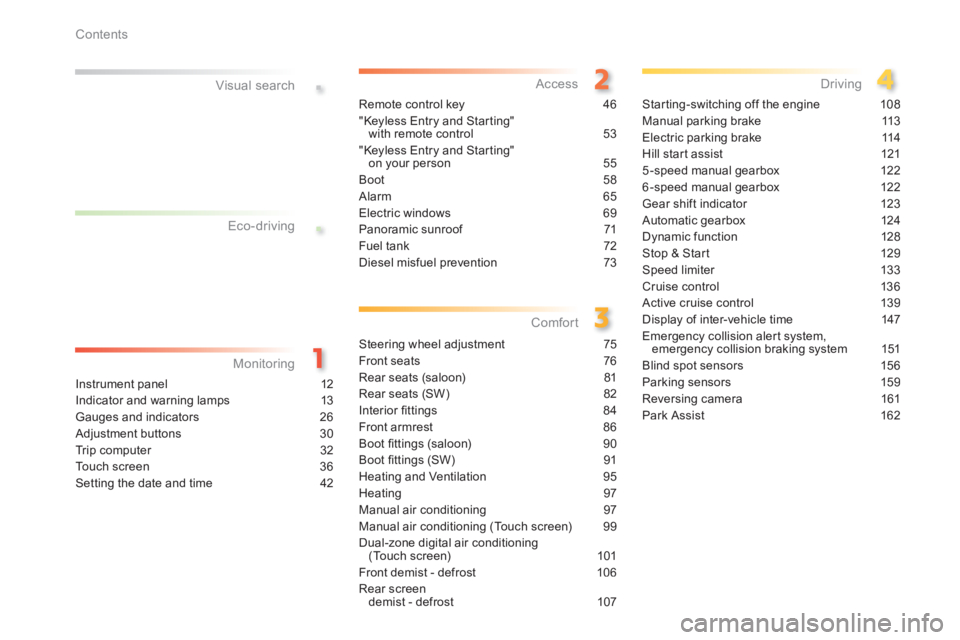
.
.
Contents
308_EN_CHAP00A _SOMMAIRE_ED02-2013
Visual search
Instrument panel 12
Indicator and warning lamps 13
Gauges and indicators 26
Adjustment buttons 30
Trip computer 32
Touch screen 36
Setting the date and time 42
Remote control key 46
"Keyless Entry and Starting" with remote control 53
"Keyless Entry and Starting" on your person 55
Boot 58
Alarm 65
Electric windows 69
Panoramic sunroof 71
Fuel tank 72
Diesel misfuel prevention 73
Steering wheel adjustment 75
Front seats 76
Rear seats (saloon) 81
Rear seats (SW) 82
Interior fi ttings 84
Front armrest 86
Boot fi ttings (saloon) 90
Boot fi ttings (SW) 91
Heating and Ventilation 95
Heating 97
Manual air conditioning 97
Manual air conditioning (Touch screen) 99
Dual-zone digital air conditioning (Touch screen) 101
Front demist - defrost 106
Rear screen demist - defrost 107
Starting-switching off the engine 108
Manual parking brake 113
Electric parking brake 114
Hill start assist 121
5-speed manual gearbox 122
6-speed manual gearbox 122
Gear shift indicator 123
Automatic gearbox 124
Dynamic function 128
Stop & Start 129
Speed limiter 133
Cruise control 136
Active cruise control 139
Display of inter-vehicle time 147
Emergency collision alert system, emergency collision braking system 151
Blind spot sensors 156
Parking sensors 159
Reversing camera 161
Park Assist 162
Eco-driving
Monitoring Access
Comfort Driving
Page 5 of 400

Contents
308_EN_CHAP00A _SOMMAIRE_ED02-2013
M i r r o r s 170
Lighting 173
Daytime running lamps 177
Automatic illumination of headlamps 178
Headlamp adjustment 180
Wipers 181
Automatic rain sensitive wipers 183
Courtesy lamps 185
Interior mood lighting 186
Temporary puncture repair kit 221
Changing a wheel 227
Snow chains 234
Changing a bulb 235
Changing a fuse 245
12 V battery 251
Energy economy mode 255
Changing a wiper blade 256
Towing the vehicle 257
Very cold climate screen 259
Towing a trailer 260
Fitting roof bars 262
Accessories 264
Bonnet 267
Petrol engine 268
Diesel engine 269
Running out of fuel (Diesel) 270
Additif AdBlue® additive and SCR system ® additive and SCR system ®
(Blue HDi Diesel) 271
Checking levels 280
Checks 283
Engines 285
Weights 285
Dimensions 286
Identifi cation markings 287
Direction indicators 187
Hazard warning lamps 187
Emergency or assistance call 188
Horn 188
Tyre under-infl ation detection 189
ESC system 193
Seat belts 196
Airbags 199
Child seats 204
Deactivating the passenger's front airbag 207
ISOFIX child seats 213
Child lock 220
Visibility
Safety Practical information
Checks Technical data
.
Emergency or assistance
289
DENON equipment 291
Touch screen 293
PEUGEOT Connect Sound (RD5) 365
Audio equipment and telematics
Alphabetical index
Page 6 of 400

4
Visual search
308_EN_CHAP00B_ AIDE VISUELLE_ED02-2013
Exterior
Wipers 181-18 4 Changing a wiper blade 184, 256
Keyless Entry and Starting remote control 53 -57, 61- 63 Remote control key 46 -52, 63 Starting 108 -112
Electronic stability programme (ESC) 193 -195 Snow chains 234 Tyre pressures 221, 233, 287 Inder-inflation detection 189-192 Changing a wheel 227-233 - tools - removing / refitting Automatic emergency braking 151-155
L i g ht i n g 173 -179 Daytime running lamps (LEDs) 177 Headlamp beam adjustment 180 Changing bulbs 235-239 - front lamps - foglamps - direction indicator repeaters
Electric windows, deactivation 69 -70
Keyless Entry and Starting 53 -57 Doors 47- 49, 51 - opening / closing - central locking - emergency control Alarm 65 - 68
Fuel tank, misfuel prevention 72-73
Panoramic sunroof 71 Roof bars, bicycle carrier 262-263 Accessories 264-265
Boot 58 - 60 - opening / closing - emergency release Temporary puncture repair kit 221-226 Warning triangle 94
Parking sensors 159 -160 Reversing camera 161 Towbar 260 -261 Towing 257-258 Park Assist 162-169
Changing bulbs 240-244 - rear lamps - 3 rd brake lamp - number plate lamps - foglamp
Door mirrors 170 -171, 179 Blind spot sensors 156 -158
Page 12 of 400

10
Eco-driving
308_EN_CHAP00C_ECO CONDUITE_ED02-2013
Optimise the use of your gearbox
With a manual gearbox, move off gently and change up without waiting. During acceleration change up early.
With an automatic or electronic gearbox, give preference to automatic mode and avoid pressing the accelerator pedal heavily or suddenly.
Control the use of your electrical
equipment
Before moving off, if the passenger compartment is too warm, ventilate it by opening the windows and air vents before using the air conditioning. Above 30 mph (50 km/h), close the windows and leave the air vents open. Remember to make use of equipment that can help keep the temperature in the passenger compartment down (sunroof and window blinds...). Switch off the air conditioning, unless it has automatic regulation, as soon as the desired temperature is attained. Switch off the demisting and defrosting controls, if not automatic. Switch off the heated seat as soon as possible.
Switch off the headlamps and front foglamps when the level of light does not require their use.
Avoid running the engine before moving off, particularly in winter; your vehicle will warm up much faster while driving.
As a passenger, if you avoid connecting your multimedia devices (film, music, video game...), you will contribute towards limiting the consumption of electrical energy, and so of fuel. Disconnect your portable devices before leaving the vehicle.
Eco-driving
Eco-driving is a range of everyday practices that allow the motorist to optimise their fuel consumption and CO2 emissions.
Drive smoothly
Maintain a safe distance between vehicles, use engine braking rather than the brake pedal, and press the accelerator progressively. These practices contribute towards a reduction in fuel consumption and CO2 emissions and also helps reduce the background traffic noise.
If your vehicle has cruise control, make use of the system at speeds above 25 mph (40 km/h) when the traffic is flowing well.
The gear shift indicator invites you engage the most suitable gear: as soon as the indication is displayed in the instrument panel, follow it straight away. For vehicles fitted with an electronic or automatic gearbox, this indicator appears only in manual mode.
Page 13 of 400
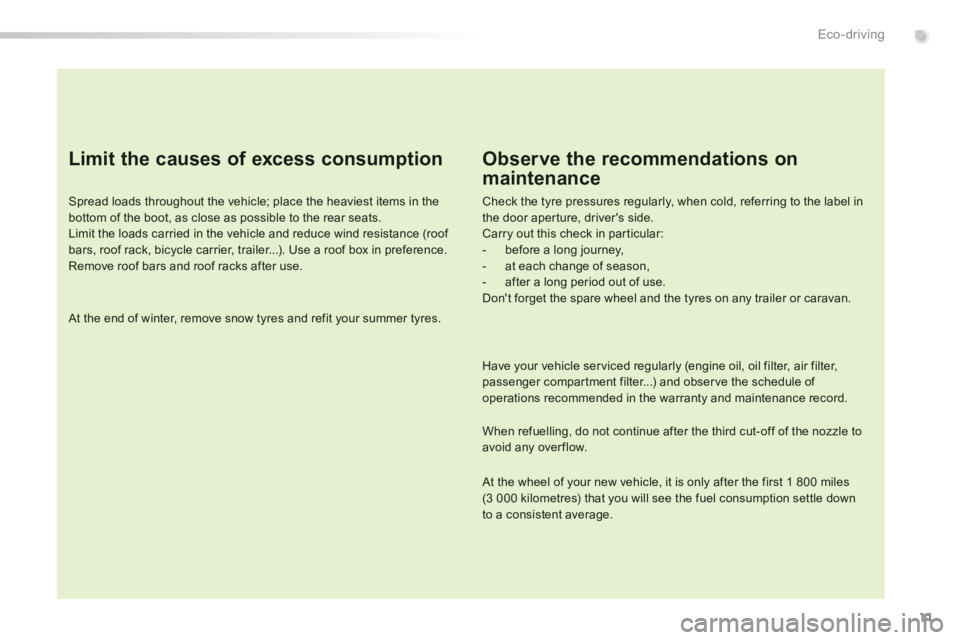
11
.Eco-driving
308_EN_CHAP00C_ECO CONDUITE_ED02-2013
Limit the causes of excess consumption
Spread loads throughout the vehicle; place the heaviest items in the bottom of the boot, as close as possible to the rear seats. Limit the loads carried in the vehicle and reduce wind resistance (roof bars, roof rack, bicycle carrier, trailer...). Use a roof box in preference. Remove roof bars and roof racks after use.
At the end of winter, remove snow tyres and refit your summer tyres.
Observe the recommendations on
maintenance
Check the tyre pressures regularly, when cold, referring to the label in the door aperture, driver's side. Carry out this check in particular: - before a long journey, - at each change of season, - after a long period out of use. Don't forget the spare wheel and the tyres on any trailer or caravan.
Have your vehicle serviced regularly (engine oil, oil filter, air filter, passenger compartment filter...) and observe the schedule of operations recommended in the warranty and maintenance record.
When refuelling, do not continue after the third cut-off of the nozzle to avoid any over flow.
At the wheel of your new vehicle, it is only after the first 1 800 miles (3 000 kilometres) that you will see the fuel consumption settle down to a consistent average.
Page 73 of 400
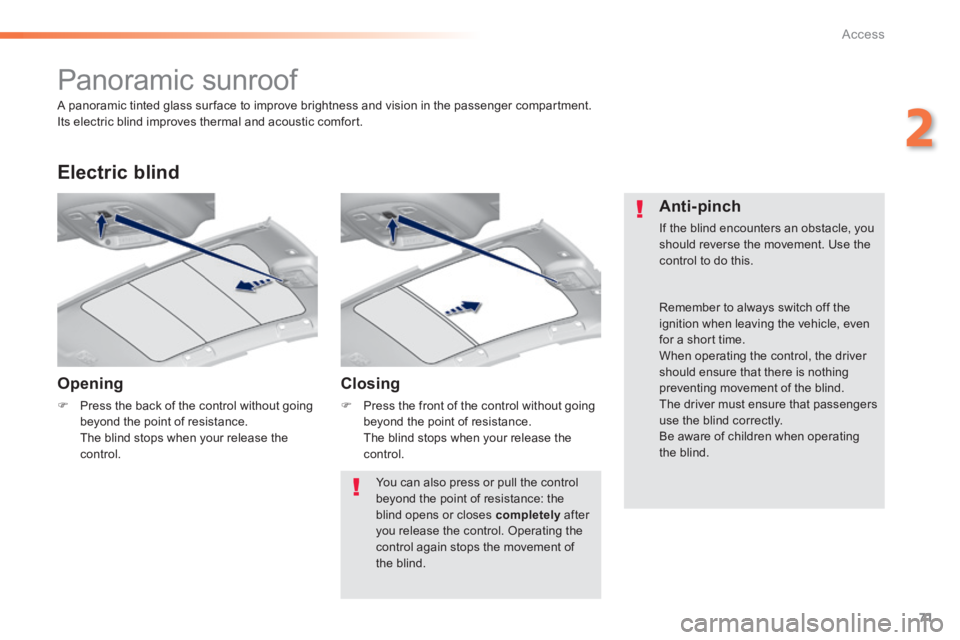
71
2
Access
308_EN_CHAP02_OUVERTURES_ED02-2013
Panoramic sunroof
Opening
Press the back of the control without going beyond the point of resistance. The blind stops when your release the control.
Electric blind
Closing
Press the front of the control without going beyond the point of resistance. The blind stops when your release the control.
Anti-pinch
If the blind encounters an obstacle, you should reverse the movement. Use the control to do this.
A panoramic tinted glass sur face to improve brightness and vision in the passenger compartment. Its electric blind improves thermal and acoustic comfort.
You can also press or pull the control beyond the point of resistance: the blind opens or closes completely after you release the control. Operating the
control again stops the movement of the blind.
Remember to always switch off the ignition when leaving the vehicle, even for a short time. When operating the control, the driver should ensure that there is nothing preventing movement of the blind. The driver must ensure that passengers use the blind correctly. Be aware of children when operating the blind.
Page 205 of 400
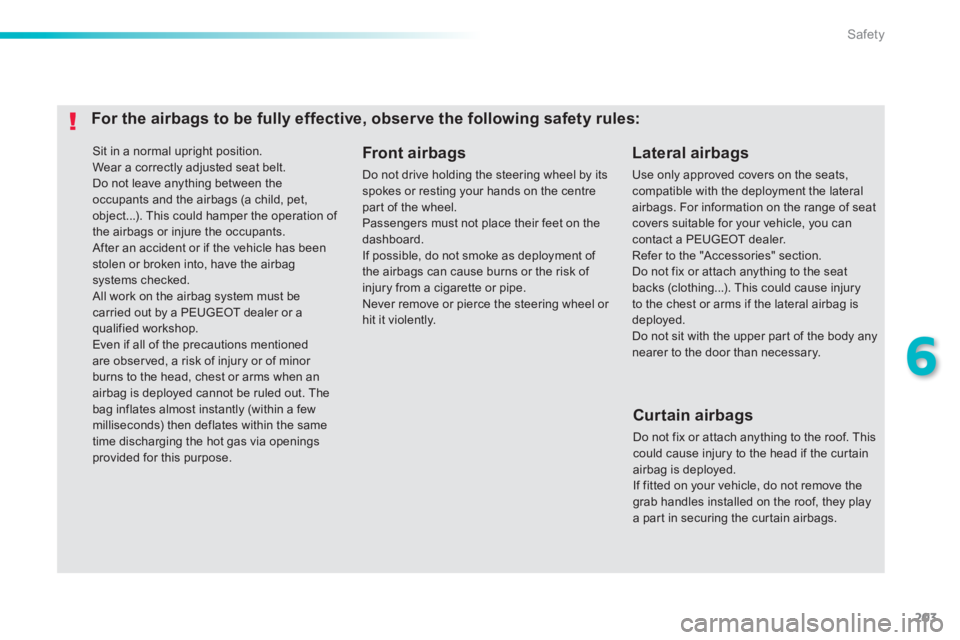
203
6
Safety
308_EN_CHAP06_SECURITE_ED02-2013
Sit in a normal upright position. Wear a correctly adjusted seat belt. Do not leave anything between the occupants and the airbags (a child, pet, object...). This could hamper the operation of
the airbags or injure the occupants. After an accident or if the vehicle has been stolen or broken into, have the airbag systems checked. All work on the airbag system must be carried out by a PEUGEOT dealer or a qualified workshop. Even if all of the precautions mentioned are observed, a risk of injury or of minor burns to the head, chest or arms when an airbag is deployed cannot be ruled out. The bag inflates almost instantly (within a few milliseconds) then deflates within the same time discharging the hot gas via openings provided for this purpose.
Lateral airbags
Use only approved covers on the seats, compatible with the deployment the lateral airbags. For information on the range of seat covers suitable for your vehicle, you can contact a PEUGEOT dealer. Refer to the "Accessories" section. Do not fix or attach anything to the seat backs (clothing...). This could cause injury to the chest or arms if the lateral airbag is deployed. Do not sit with the upper part of the body any nearer to the door than necessary.
Front airbags
Do not drive holding the steering wheel by its spokes or resting your hands on the centre part of the wheel. Passengers must not place their feet on the dashboard. If possible, do not smoke as deployment of the airbags can cause burns or the risk of injury from a cigarette or pipe. Never remove or pierce the steering wheel or hit it violently.
For the airbags to be fully effective, observe the following safety rules:
Curtain airbags
Do not fix or attach anything to the roof. This could cause injury to the head if the curtain airbag is deployed. If fitted on your vehicle, do not remove the grab handles installed on the roof, they play a part in securing the curtain airbags.
Page 264 of 400
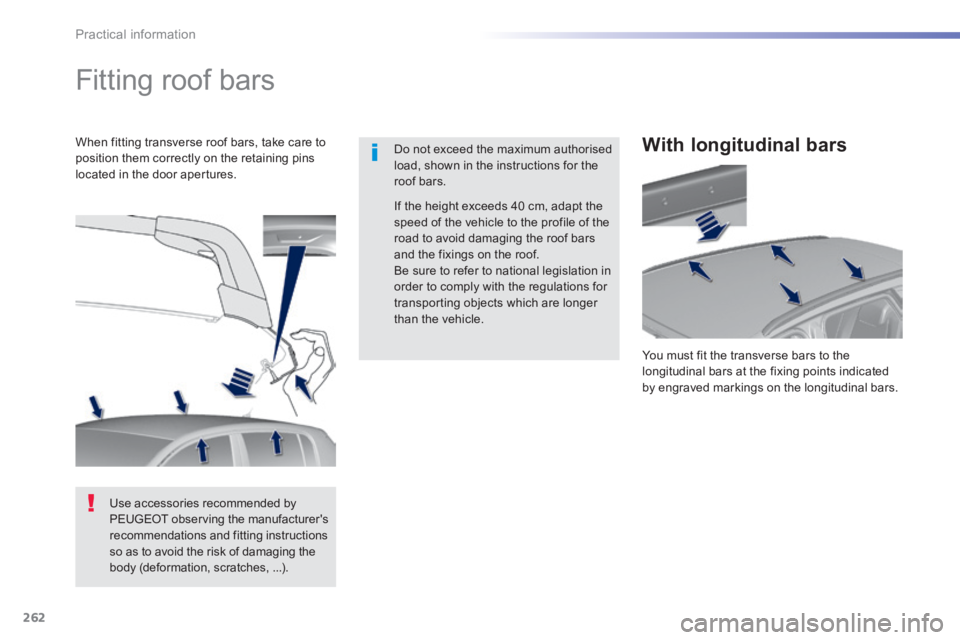
262
Practical information
308_EN_CHAP07_INFO PR ATIQUES_ED02-2013
Fitting roof bars
Do not exceed the maximum authorised load, shown in the instructions for the roof bars.
When fitting transverse roof bars, take care to position them correctly on the retaining pins located in the door apertures.
Use accessories recommended by PEUGEOT observing the manufacturer's recommendations and fitting instructions so as to avoid the risk of damaging the body (deformation, scratches, ...).
If the height exceeds 40 cm, adapt the speed of the vehicle to the profile of the
road to avoid damaging the roof bars and the fixings on the roof. Be sure to refer to national legislation in order to comply with the regulations for transporting objects which are longer than the vehicle.
With longitudinal bars
You must fit the transverse bars to the longitudinal bars at the fixing points indicated by engraved markings on the longitudinal bars.